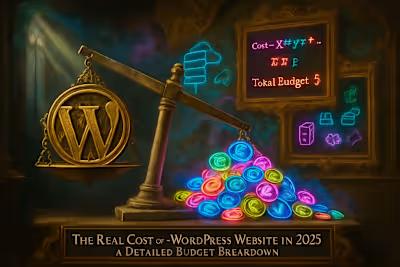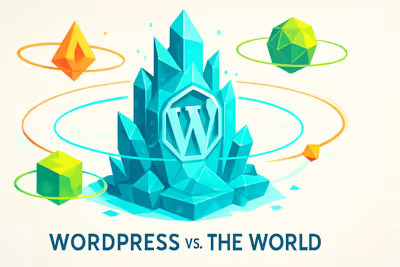Beyond Screenshots: Crafting WordPress Case Studies That Convert

Beyond Screenshots: Crafting WordPress Case Studies That Convert
Why Case Studies Are More Powerful Than Simple Portfolio Items
Moving from 'What' to 'Why' and 'How'
Demonstrating Value Beyond Code
The Anatomy of a Perfect WordPress Case Study
The Client and The Challenge
The Project's Objective
Your Process and The Technical Solution
The Results and Key Metrics
Choosing and Presenting Your Case Studies
Prioritize Projects That Showcase Problem-Solving
Showcase a Variety of Skills
Storytelling, Visuals, and Readability
References
Beyond Screenshots: Crafting WordPress Case Studies That Convert
A standout portfolio is essential for any WordPress freelancer. While showcasing your finished work is good, detailing your process and results in a case study is what truly sells your expertise. A powerful portfolio, combined with building a strong personal brand, creates an unstoppable combination for attracting high-value clients. This guide will walk you through creating case studies that do just that, helping clients understand why they should hire top WordPress freelancers like you.
Think about the last time you hired someone for an important project. Did you choose them based solely on pretty pictures? Probably not. You wanted to understand their thinking process, their approach to challenges, and most importantly, their ability to deliver real results. That's exactly what your potential clients are looking for when they browse through WordPress developer portfolios.
Why Case Studies Are More Powerful Than Simple Portfolio Items
Let's face it: anyone can post screenshots of websites they've built. But screenshots alone tell only a fraction of the story. They're like showing someone a finished cake without explaining the recipe, the techniques used, or why it tastes so good.
Case studies transform your portfolio from a simple gallery into a powerful sales tool. They demonstrate critical thinking, showcase your problem-solving abilities, and prove you can deliver tangible results. These are the exact qualities that make clients reach for their wallets.
Moving from 'What' to 'Why' and 'How'
A typical portfolio item shows what you built. It's a static snapshot that leaves viewers guessing about everything else. But a well-crafted case study? It tells the complete story.
When you explain why certain decisions were made and how you achieved specific outcomes, you create a narrative that engages potential clients on a deeper level. Instead of thinking "nice website," they start thinking "this person really understands business challenges."
For example, rather than just showing a beautiful e-commerce site, your case study might explain why you chose WooCommerce over other solutions, how you optimized the checkout process to reduce cart abandonment, and why specific design elements were crucial for the target audience. This narrative approach helps clients visualize how you'd approach their unique challenges.
Demonstrating Value Beyond Code
Here's a truth many developers miss: clients don't hire you for your coding skills alone. They hire you to solve business problems. Case studies let you showcase your understanding of client goals, user experience, and business objectives.
When you demonstrate this broader perspective, you position yourself as a strategic partner rather than just another coder. You show that you can think beyond functions and plugins to consider conversion rates, user engagement, and bottom-line results.
This shift in positioning is powerful. It moves you from the "expense" category to the "investment" category in your client's mind. And investments? They command higher rates and attract better projects.
The Anatomy of a Perfect WordPress Case Study
Creating a compelling case study isn't about following a rigid template. It's about telling a story that resonates with potential clients while showcasing your expertise. However, certain elements are essential for maximum impact.
A great case study reads like a mini business transformation story. It has conflict (the challenge), a hero (you), and a satisfying resolution (the results). Let's break down each crucial component.
The Client and The Challenge
Every great story starts with context. Begin your case study by introducing the client and painting a clear picture of their situation before you entered the scene. This isn't just about listing problems – it's about making those problems feel real and relatable.
Instead of writing "The client needed a faster website," try something like: "Sarah's online boutique was losing customers daily. Her beautiful product photos took forever to load, and frustrated shoppers were abandoning their carts at an alarming rate. With peak season approaching, she needed a solution fast."
See the difference? The second version creates urgency and helps readers connect emotionally with the challenge. When potential clients see themselves in these scenarios, they're already imagining how you could help them too.
The Project's Objective
After establishing the challenge, clearly define what success looked like for this project. Specific, measurable goals are crucial here. Vague objectives like "improve the website" won't cut it.
Strong objectives might include:
Reduce page load time by 50% within 30 days
Increase mobile conversion rates by 25%
Integrate inventory management with three different suppliers
Achieve a perfect score on Core Web Vitals
These concrete goals accomplish two things. First, they show you understand business metrics that matter. Second, they set up the "before and after" comparison that makes your results section powerful.
Your Process and The Technical Solution
This is where you get to shine as a problem solver. Don't just list the tools you used – explain your thinking process. Walk readers through your approach step by step.
Start with your discovery phase. How did you diagnose the specific issues? What research or testing did you conduct? Then move into your solution strategy. Why did you choose certain plugins over others? What custom functionality did you develop and why?
For instance: "After analyzing the site's performance, I discovered that unoptimized images and bloated theme code were the main culprits. I implemented a three-pronged approach: custom lazy loading for images, switching to a lightweight theme framework, and implementing advanced caching strategies using specific plugins."
Remember to balance technical details with business reasoning. Your goal is to demonstrate expertise while keeping non-technical clients engaged.
The Results and Key Metrics
This is your moment of triumph – make it count. Results should be specific, measurable, and directly tied to the objectives you outlined earlier. Numbers speak louder than adjectives ever could.
Instead of "The site is much faster now," present data like:
Page load time decreased from 8.2 seconds to 2.1 seconds (74% improvement)
Mobile conversion rate increased from 1.8% to 2.4% (33% increase)
Bounce rate dropped from 68% to 41%
Revenue increased by $15,000 in the first month post-launch
But don't stop at numbers. Include client testimonials that speak to the business impact. A quote like "The site improvements paid for themselves in just six weeks" carries serious weight with prospects evaluating your services.
Choosing and Presenting Your Case Studies
Not every project deserves the case study treatment. Selecting the right projects and presenting them effectively can make the difference between a portfolio that generates leads and one that gets ignored.
Think of your case studies as your greatest hits album. Each one should showcase different aspects of your expertise while maintaining consistently high quality. The projects you choose and how you present them will shape how potential clients perceive your capabilities.
Prioritize Projects That Showcase Problem-Solving
The best case studies feature clear, challenging problems that you successfully solved. These create compelling narratives that keep readers engaged and demonstrate your value as a problem solver.
Look for projects where you:
Overcame significant technical challenges
Delivered exceptional results despite constraints
Found creative solutions to complex requirements
Rescued failing projects or fixed others' mistakes
A project where you simply implemented a client's exact specifications might be professionally executed, but it won't showcase your strategic thinking. Choose projects where your expertise made a real difference to the outcome.
Showcase a Variety of Skills
Your case study collection should work like a well-curated gallery, with each piece highlighting different capabilities. This variety helps you appeal to a broader range of potential clients while demonstrating your versatility.
Consider including case studies that showcase:
E-commerce expertise: WooCommerce customizations, payment gateway integrations, inventory management solutions
Performance optimization: Speed improvements, Core Web Vitals optimization, server configuration
Custom development: Unique plugins, theme development from scratch, API integrations
Migration projects: Moving from other platforms, upgrading legacy systems, consolidating multiple sites
Security hardening: Recovering hacked sites, implementing advanced security measures
Each case study becomes a proof point for a specific skill set, building a comprehensive picture of your capabilities.
Storytelling, Visuals, and Readability
A case study with amazing results can still fall flat if it's poorly presented. Your presentation should be as polished as the work you're showcasing.
Tell a story, don't write a report. Use narrative techniques to create tension and resolution. Build up the challenge, walk through your process with suspense, and deliver the results as a satisfying conclusion.
Use visuals strategically. Include before-and-after screenshots, performance graphs, and workflow diagrams. But don't overdo it – each visual should serve a purpose. A cluttered case study is as bad as a cluttered website.
Format for scanability. Use clear headings, bullet points for key results, and callout boxes for important quotes. Many potential clients will scan before they read, so make sure your key points jump off the page.
Keep it concise but complete. Aim for 800-1200 words per case study. This gives you enough space to tell the full story without losing reader attention. If you have more to share, consider creating a detailed version for interested prospects.
Creating powerful WordPress case studies takes time and effort, but the payoff is substantial. Each well-crafted case study becomes a sales tool that works 24/7, convincing potential clients that you're the right person for their project.
Start by selecting your best project from the past year. Document the challenge, your process, and the results. Add compelling visuals and client testimonials. Then watch as your portfolio transforms from a simple showcase into a client-converting machine.
Remember, every successful WordPress freelancer has a portfolio. But those who thrive have case studies that tell the story behind the work. Make sure your stories are worth telling – and more importantly, worth buying.
References
Like this project
Posted Jul 6, 2025
Your portfolio is more than a gallery. Learn how to write compelling WordPress case studies that showcase your problem-solving skills and turn prospects into clients.










